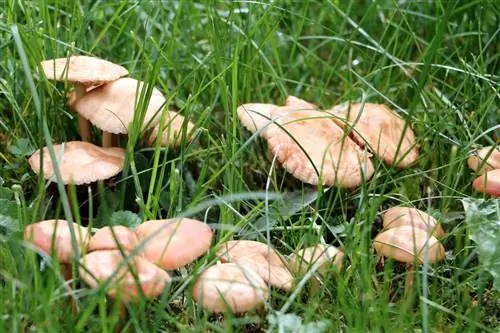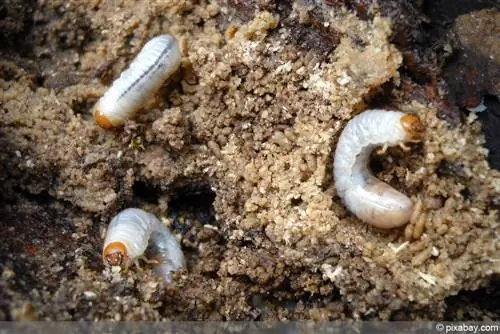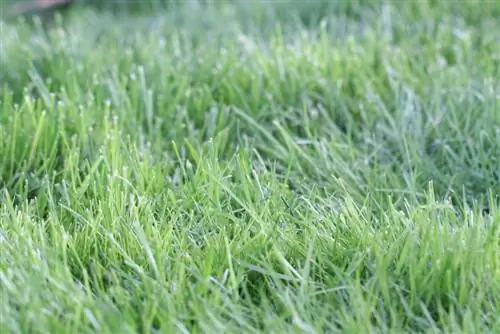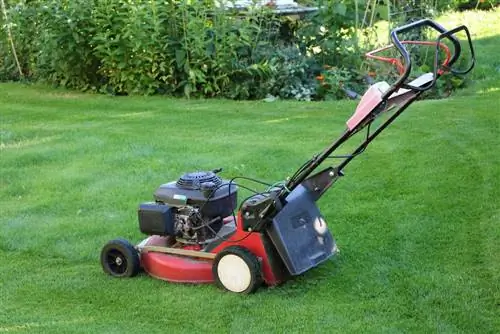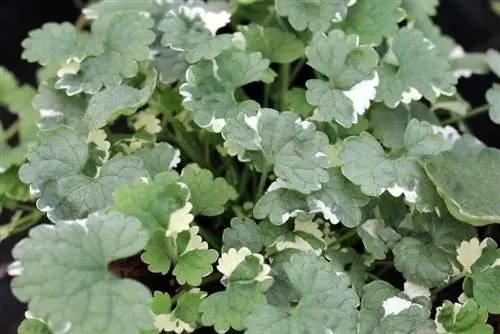- Author admin [email protected].
- Public 2023-12-17 03:39.
- Last modified 2025-01-24 12:45.
Once the Gundermann, also known as the real Gundelvine, has moved into the garden, it spreads rapidly in all directions and also takes over the lawn. Here it not only spoils the well-maintained appearance, but also seriously damages the lawn if it is not removed quickly. Therefore, you should react quickly. As a weed, Glechoma hederacea is very stubborn and resists many control methods. But below you will find out which effective strategies and preventative measures offer the solution to the weed problem.
Recognize
If you have not specifically planted this type of labiate as a ground cover in the garden, you should know exactly which plant it is before any weed control on the lawn so that you can take the right measures. You can recognize the Gundermann by the following appearance:
- Stems and undersides of leaves often have purple color
- Spring axes running across the ground that have no flowers
- Flowers only on the rising stems
- Blue-violet flowers are up to about 1.5 centimeters tall
- Ground runners have some nodes that take root
- Reaches a lateral length of over two meters
- Possible height growth of around 30 centimeters
- Kidney-shaped to roundish-heart-shaped leaves with a maximum length of four centimeters
- Blunt or tapering leaf ends
- Nut-like fruits ripening between June and August
- Flowering time: between April and July
- Special feature: when a leaf is crushed, an oily film and a spicy-tart smell are created
Occurrences
The real ground vine is sometimes planted as a ground cover, but in many cases it finds its way into gardens through wild propagation. The seeds are mainly carried into the neighborhood by the wind and birds. But they also stick under shoes and get onto the lawn. Light, nitrogen-containing, moist lawns are particularly preferred.
As they spread quickly and become stronger and wider due to their nodal roots, they move across lawns into flower beds, swimming pools embedded in the lawn and do not stop in front of terraces adjacent to the lawn. Removing them there is of no use, because the point of origin and all the branches extending from it in the lawn have to be found. This is the only way to stop further growth.
Manual control
It is very difficult to pull out Gundermann if it has already taken root at various nodes and is spreading in all directions. For this reason, you should check your lawn regularly at short intervals for the common ground vine. This is the only way you have the opportunity to discover a plant in the lawn at an early stage and remove it before further shoots and seeds form.
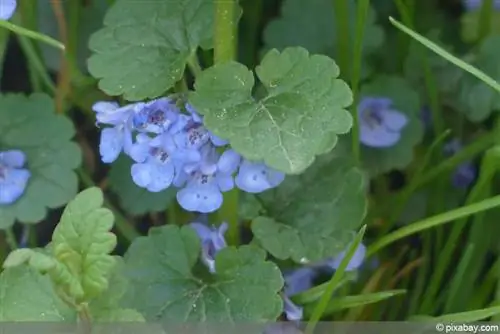
Hand Removal
If the real ground vine has just emerged, it can usually be easily pulled out of the lawn. In order to fully extract the root in this way, the soil should be wet. Removing them by hand is much more complex when specimens are already far out. The hand method can also work here, but this may mean searching the lawn for a few meters in a crouched position for rooted nodes.
Weeder
The Glechoma hederacea is one of the shallow-rooted plants, which is why it can easily be pulled out with the roots using a special weed cutter. The advantage over hand removal is that you don't have to bend down and therefore protect your back.
Tip:
If you have completely grown the plant and want to dispose of it in the compost, it is advisable to let the roots dry out completely on a stone or something similar in direct sun. If you don't do this, there is a chance that the roots will sprout again on the compost and grow again.
Mechanical combat
Some mechanical combat methods with the support of various aids are not necessarily more convenient or faster, but just as effective.
Verticutting
The Gundermann seed needs, among other things, light to grow and sprout. It therefore has less chance of germinating and developing fully as a young plant between compacted lawns. For this reason, in theory you should not scarify - BUT compacted lawns provide an optimal basis for many other types of weeds and ultimately damage the lawn visually and in terms of he alth. It is therefore advisable to scarify the lawn, especially where it is heavily compacted. During the gardening season, twice is usually sufficient. You should then scatter new lawn seeds to fill gaps and thus achieve a natural lawn density. This also limits seed germination and growth.
Lawn fertilization
Real ground vines require nitrogen-containing soil for their existence, just like lawns. If you have discovered the plant in your lawn, it is necessary to avoid nitrogen-containing fertilizers. This may result in your lawn losing its rich green color, but the groundworm is prevented from spreading and slowly dies. You can then spread a fertilizer with nitrogen on your lawn that works quickly. For example, ammonium, nitrate and urea are forms of nitrogen that have rapid effectiveness. The lawn recovers quite quickly afterwards.
You can also fertilize your lawn with natural fertilizer while nitrogen is being withdrawn. This allows him to survive this nitrogen-poor phase better.
Weed killer
Be careful when buying weed killers. Many products contain substances that even promote the growth of dicot plants such as Gundermann. It is strongly advisable to pay close attention to the product descriptions and seek professional advice if necessary.
This not only applies to control in the lawn, but also to the use of normal weeds in beds that directly adjoin the lawn and in which Glechoma hederacea is located. With a growth-promoting weed killer, there is a good chance that you will lose control and the Gundermann will quickly spread from the bed to the lawn.
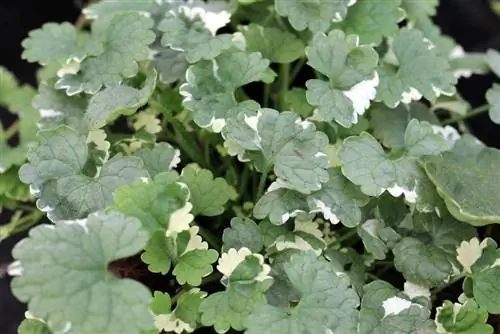
For the lawn, we only recommend using a special weed killer that is aimed at dicotyledonous plants. However, you should make sure that they are not used too close to a bed where the plant specifically functions as ground cover. The distance should be at least one meter and the soil should not be over-wetted so that the weed killer does not reach too large an area. It should also be distributed evenly along the entire ground sprouts so as not to miss any root points. Reseeding lawns is usually only possible after two months of application.
Prevention
Basically, nothing really works reliably as a preventative measure. You can maximally reduce the chance of germination and spread.
Lawn sheaths
Cut your lawn regularly and keep it consistently at a height of between four and five centimeters. Seeds that have already penetrated receive less or no light and are prevented from germinating. Regular lawn cutting also ensures a stronger blade of grass and dense growth, making it more difficult for seeds and the resulting roots to reach the soil.
Continuous lawn cutting also reduces the nitrogen content in the soil, as the lawn absorbs it to grow after each cut and accordingly there is less available in the soil. This means that an important soil property that the Gundermann needs to grow is missing.
Lawn cutting
After each lawn cutting, remove all grass clippings from the surface. This will compost after a while, especially if there is adequate moisture. This means that it can secrete nitrogen when it remains lying down and increase the nitrogen content in the soil again.
Lawn Control
The best time to check the lawn is when you cut the lawn. Walk over the surface of the lawn with your eyes open and look out for the first signs of groundworm. This allows you to discover the rapidly growing plant and remove it at an early stage of growth.
Conclusion
Scarifying the lawn is one way to combat groundworm. But here it is important to ensure that a maximum number of twice is not exceeded in order not to create a more favorable situation for the plant. With the other methods described here, you can achieve effective results that will ensure a long-term lawn without a real ground vine if you use them quickly when you first see them.


